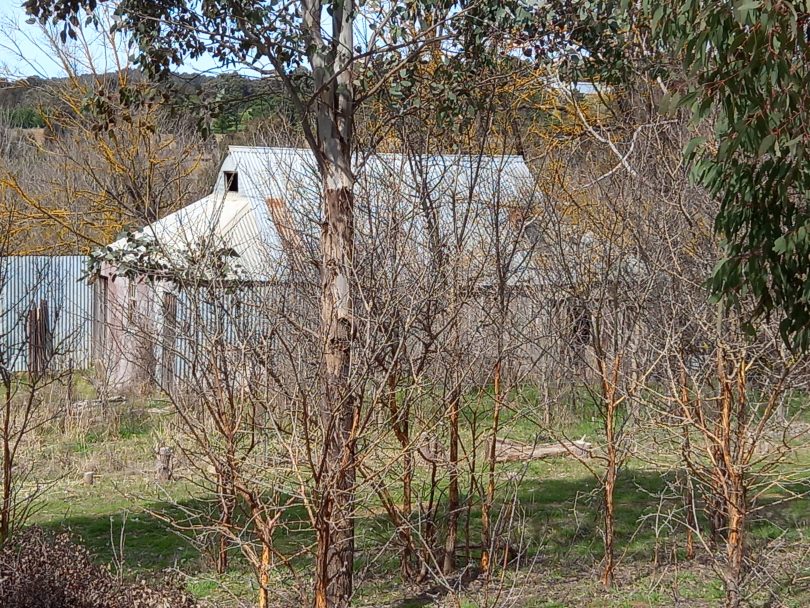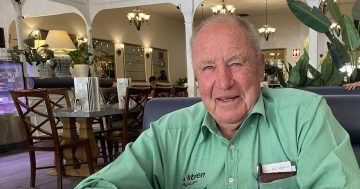
Yass River Road winds travellers back to an earlier era. Photo: Judith Davidson.
Now lockdowns are well and truly behind us – hopefully for good – it’s time to make the most of the treasures right on our own doorstep.
Yass River Road provides a fascinating glimpse of rural life, past and present. Once through the tunnel under the Barton Highway, motorists emerge into a different world.
The narrowing bitumen road is lined with hobby farm-size blocks adorned with comfortable modern houses. Yet with a little imagination, and a few more kilometres, it is not difficult to sense the earliest settlers in the 1840s making homes for themselves and their ever-growing families on similar size blocks with timber slabs and bark-roofed huts in this secluded river valley.
There is no shortage of water at the moment. The river is running fast and strong, with Booths Crossing closed and the debris line in several places marking the height of past floods.
It is obvious Yass River Road floods and, in the gravel sections, the road deteriorates into potholes and gutters. Definitely to be left alone when wet.
Along the road, Yass River is crossed four times. Three of those crossings are now narrow bridges named after the settler families of Buckmaster, Thompson and Walmsley.
Once, the unformed river crossings provided a dangerous challenge to horses and buggies. In 1892, John Thompson was thrown from his buggy and killed.
The coroner reported: “In getting over the river known as Buckmasters Crossing, the deceased and his daughter had hold of the reins, and each happened to pull on the horse in the opposite way, which brought the wheels under the vehicle and caused it to capsize, throwing the deceased against the embankment … his skull being fractured.”
John Thompson is buried behind Mundoonan Church, just a few more kilometres along Yass River Road. His substantial monument contrasts with the simple grave of Noah and Mary Davies, who had land further up the river at Mount Pleasant.
They were both Sunday school teacher and preacher in the first primitive church that served as chapel, school and meeting place to the hardy Wesleyan community along the river.
A team of neighbours, led by John Thompson and his brother, James, who had settled nearby at Greenfields in the 1850s, rebuilt the church, but this time in brick. The date 1862 is still visible above the entrance. The Johnson’s who are buried there are also remembered in the next lane going off to the right: Johnsons Road.
The country seems rugged, often covered in quite dense eucalypt scrub interspersed with rocky outcrops, but the attraction for the early settlers were the patches of fertile river flats and water.

O’Leary’s Homestead as it looks today. Photo: Judith Davidson.
After safely negotiating Buckmasters’ Crossing, the road snakes along the river to ‘Edgerton’, named after Joseph Edgerton who arrived in the valley to take up his small block around the 1840s. The name is on the gate and the solid stone house set back from the road suggests success.
Now divided into smaller lots, ‘Edgerton’ and its old outbuildings hide a grim secret. The Indigenous Yass Valley people were forcibly resettled here from their homes on the outskirts of Yass in 1913. By 1916, Edgerton Mission was closed, with most families returning to the Oak Hill settlement in Yass.
The original Thompson property, ‘Greenfields’, is followed by ‘Elizabeth Fields’, which was also the name of one of the one-teacher primary schools scattered along the river valley.
The school was built on William and Elizabeth Petty’s block to school a tribe of Petty, Walmsley and Armstrong children. There were schools established at Manton and Edgerton, too, in response to the growing population of ‘wild bush children on the river’.
A kinder reference by school teacher Bertha Johnson recalls: “There was a deep friendship among these children, and I never remember settling a quarrel.”
After Greenwood Lane, the gravel road narrows, twisting around sharp bends up through eucalypt arches and over undulating hills, fringed with yellow-flowering wattle.
Long converted to a shearing shed, the original O’Leary Homestead still stands with 1880s newspapers pasted across the slab walls, a practical way to keep out the drafts.
By this point, 21st century Australia has disappeared.
Judith Davidson is a local historian, uncovering the stories of the Yass Shire.
Original Article published by Judith Davidson on Riotact.









